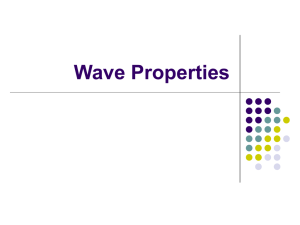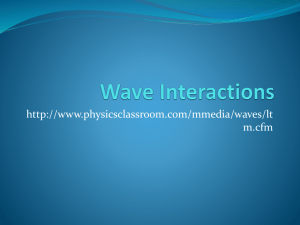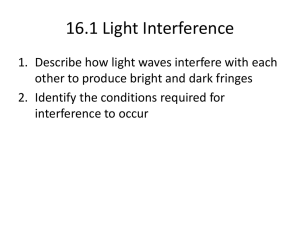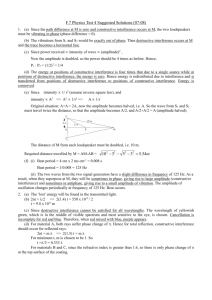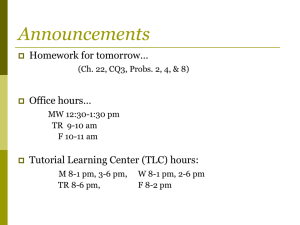Waves Interactions
advertisement
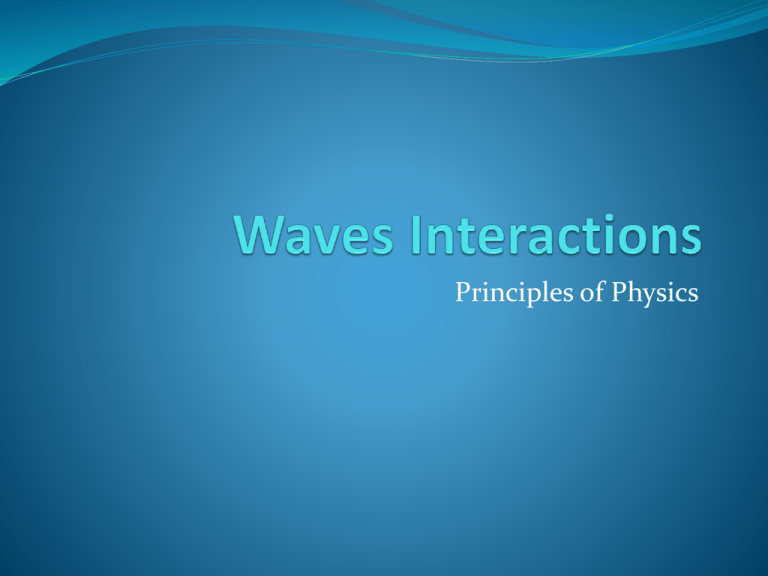
Principles of Physics Boundary Where 2 media meet Where wave conditions change Reflection, transmission, or both can occur Waves at Boundaries A wave travels from one medium to another (i.e. air into water) - Waves enter the new medium upright - How much energy is transmitted into the new medium depends on how different the media are. - The greater the difference in the media the less transmission - More of the energy is reflected (returns to the original medium) Free/Open/Loose Boundary Boundary that can move - Boundary moves in response to the wave - When wave travels from: - More dense to less dense - Wave remains upright upon reflection - Less dense to more dense - Wave flips upon reflection Waves at Boundaries When the wave goes from low density to high density the reflected wave is flipped (In this case it would return on the bottom) Waves at Boundaries Fixed Boundary Boundary that does not move - Most energy is reflected - Wave flips upon reflection (crest becomes a trough) Boundary Conditions Absorption In the real world - some of the energy is absorbed by the medium in the form of heat (usually as a result of friction) - Some of the wave amplitude is lost as a result Interference -when the particles of a medium are affected by multiple waves at the same time -the vibration of each particle is the combination of the vibration that would occur as a result of each individual wave Types of Interference Constructive Interference: When multiple waves add up to create a larger amplitude Types of Interference Destructive Interference: When multiple waves add up to create a smaller amplitude Interference Constructive Interference Destructive Interference Standing Waves occur when a wave is confined between two boundaries Wave is reflected back and forth The medium appears to be reflecting back and forth vertically • As the frequency changes the standing wave pattern changes • low frequency, long wavelength • high frequency, short wavelength Standing Waves Standing Waves applet Standing Waves Interference occurs between the wave and its reflection Where destructive interference occurs, nodes form Node – particle remains at equilibrium Where maximum constructive interference occurs, antinodes form Antinode – particle is farthest from equilibrium Diffraction “Bending” of waves around a boundary - no change in medium - When a straight wave front hits a boundary the edges appear curved Diffraction The amount of bending that is noticeable depends on the wavelength and the size of the opening Wavelength ≥ slit size → more bending Wavelength < slit size → less bending Diffraction and Interference When there are multiple openings the diffracted waves will overlap and interfere Constructive interference occurs where crests happen at the same time and place (where lines overlap on the diagram) Destructive interference occurs where a crest and a trough happen at the same time and place (where lines overlap spaces on the diagram) Diffraction and Interference Where constructive interference occurs an increase in amplitude occurs (brighter area on diagram) Wave form is magnified Where destructive interference occurs a decrease in amplitude occurs (grey areas on diagram) Wave form is cancelled out What Depends on What Frequency: depends on source Amplitude: depends on energy Speed: depends on medium




